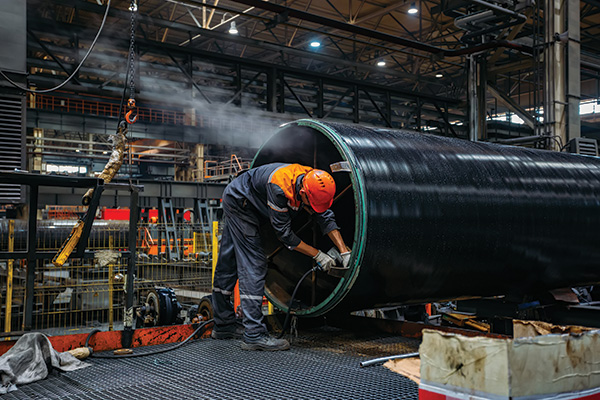March 2020, Vol. 247, No. 3
Features
Controlling Microbiologically Influenced Corrosion in Pipelines
By Gretchen Jacobson, Materials Performance Managing Editor, NACE International
Microbiologically influenced corrosion (MIC) refers to corrosion caused by the presence and activities of microorganisms – microalgae, bacteria, archaea, and fungi. While microorganisms do not produce unique types of corrosion, they can accelerate corrosion reactions or shift corrosion mechanisms.
Microbial action has been identified as a contributor to rapid corrosion of metals and alloys exposed to soils; seawater, distilled water, and freshwater; crude oil, hydrocarbon fuels, and process chemicals; and sewage. Many industries and infrastructure are affected by MIC, including oil production, power generation, transportation, and water and wastewater.
In this article, which focuses on preventing and controlling MIC in pipelines, three experts share their knowledge and experience. They are Richard Eckert, DNV GL-North America Oil & Gas; Jason Lee, U.S. Naval Research Laboratory; and Torben Skovhus, VIA University College.
NACE: At what point in your career did you begin your involvement with microbiologically influenced corrosion (MIC), and why?
Richard Eckert: I started work in the natural gas industry in 1982 and was introduced to MIC shortly thereafter when I became involved with the Gas Research Institute’s (GRI) MIC research program.
At the time, Dan Pope and Tim Zintel of Bioindustrial Technologies Inc. were doing a considerable amount of the research on both internal and external MIC of pipelines. A number of major pipeline companies were also supporting the research with field test sites and samples, as was my company.
Working with the GRI researchers from academia was educational and exciting, particularly since there was almost no practical guidance on MIC identification or mitigation published for the oil and gas industry.
I worked with my colleagues from ANR Pipeline on field testing biocides for liquids being produced offshore in the Gulf of Mexico and studying biofilms and corrosion initiation on coupons. At times when working offshore, we would rent an extra hotel room to use as a lab, filling it with cases of culture supplies and setting up hot plates and microscopes. Of course, this would probably not go over well today! From that point on I was hooked on MIC.
Jason Lee: I began my involvement in MIC after being hired by the Naval Research Laboratory (NRL) and working with Dr. Brenda Little in 2001. Dr. Little recruited me when I was finishing up my Master’s degree in Materials Science and Engineering at the University of Virginia (UVa) under the direction of professor Robert Kelly.
Dr. Little was interested in hiring me because my undergraduate work involved chemistry and cellular/molecular biology in addition to the corrosion background from UVa. Prior to meeting Dr. Little, I did not know MIC was a field of study. I never thought my two, very different fields of study would ever complement each other so well. Dr. Little was the one who encouraged me to continue my education, get a Ph.D., and ultimately take over the MIC program at NRL.
Torben Skovhus: My involvement was right after finishing my Ph.D. in Denmark in 2004 on how natural antifouling compounds produced by bacteria could be applied in coatings and paints in the marine environment.
I got a job as a consultant where some of our major clients were oil and gas operators based around the North Sea. They had great interest in corrosion in general and MIC in particular. It was more or less a coincidence that I came to work with MIC in close collaboration with the late Mr. Jan Larsen. He was a great mentor for me for more than 10 years.
NACE: What types of environments and situations can be prone to MIC in oil pipelines?
Eckert: MIC occurs when chemical, microbiological, and physical conditions support the active growth of biofilms containing specific types of microorganisms on the pipe surface and the resulting growth aids the electrochemical processes, leading to corrosion. The most important parameter is the presence of water, even if only a small volume is present. In liquid hydrocarbon pipelines, water can accumulate when there is low or no flow, such as in a facility’s piping dead leg.
Transmission quality crude oil often contains less than 0.5% volume sediment and water; however, if 5,000 barrels of crude are not flowing in a section of the pipeline, 0.5% or 25 barrels of water could still drop out and settle in a low point in the pipeline elevation profile. If the pipeline begins flowing at a velocity high enough to entrain the water, eventually it will be removed. However, if the water is not re-entrained in the hydrocarbon, then the accumulated water could be removed by pigging or treated with a biocide to reduce the potential for MIC.
It is often believed that low numbers of culturable bacteria in the liquid phase indicate that MIC is not a threat for a particular pipeline; however, the numbers and types of microorganisms that are present in the liquid phase are not always representative of the types and numbers attached to the pipe surface.
These attached, or sessile, microorganisms in biofilms are those that have the greatest influence on localized corrosion. The industry is starting to pay more attention to biofilms because of their contribution to the threat of MIC, and a new NACE Task Group (TG 586) was just formed to develop methods of testing biocides to control corrosion under biofilms.
Another newly formed Task Group (TG 561) is developing a standard that will help standardize the use of molecular microbiological methods (MMM); for example, DNA-based and enzyme-based test methods that have gained popularity in the last decade in the oil and gas industry. MMMs provide far more information about biofilm communities than traditional culture-based methods and improve operators’ ability to diagnose MIC problems in their assets.
Lee: Working for the Navy, my experience in MIC is more in the marine environment, in general, rather than oil pipelines. However, I have been involved with projects that examine the interactions of hydrocarbon fuels under storage conditions in marine environments.
Military platforms and facilities store huge amounts of fuel. Some of these systems have seawater intentionally introduced to provide ballast while others have unintentional seawater/freshwater introduction. Microorganisms require water for proliferation and growth.
Hydrocarbon fuels provide carbon sources (electron donors) for microbial metabolism. Seawater itself is highly corrosive and can drive abiotic corrosion. The addition of fuel to seawater can cause the microbial components to produce corrosion metabolites such as sulfides and acids, and in combination with the chloride from seawater, produce a highly corrosive environment.
Skovhus: If seawater is applied as a secondary recovery strategy to maintain the downhole pressure of the oil reservoir, problems can rapidly develop from hydrogen sulfide (H2S) being produced either in the reservoir, the process pipework or in the pipeline itself. The problem can develop rapidly if a detailed corrosion management strategy has not been put in place.
NACE: In your experience, which are the most effective methods to control MIC in pipeline systems?
Eckert: By far, mechanical cleaning using various types of maintenance pigs to disrupt and remove biofilms is one of the most effective ways to control MIC in pipelines. Even if biocide or other chemical treatments are used, biofilms may not be adequately penetrated by these chemicals and thus their effectiveness is limited unless the biofilm can be broken up or removed by pigging.
A combination of chemical treatment and pigging may be used when the threat of MIC is significant. Chemical treatment with biocides and surfactant compounds is sometimes applied continuously at a low dose and/or intermittently as a batch treatment. Facility piping deadlegs may be flushed on a regular basis to remove water and solids, and then have biocides added to help control biofilms in between flushing treatments.
It is nearly impossible to prevent bacteria from entering a pipeline with the gas or liquids being produced or transported, as bacteria are very small (i.e., only a few microns in length) and can reproduce exponentially under the right conditions.
Similarly, it is impossible to kill all microorganisms in a pipeline, since they are often protected by the solid deposits and the exopolymers encompassing the biofilm. Small organic and inorganic solid particles that make up pipeline “sludge” deposits provide water films, nutrients, and present an enormous surface area for attachment and protection of microorganisms.
Lee: The most effective method to prevent MIC is diligent and proper housekeeping. All systems that I work with are open to the environment and thus can never be sterile. Biocides are useful in some closed systems, but open systems that have frequent water addition are not suitable for biocide treatment.
Coatings are often used to prevent microbial access to the underlying metal substrate, but coatings can chemically or mechanically degrade over time. Keeping detailed records of systems that are known to be susceptible to MIC is an absolute must; then proper maintenance and cleaning cycles can be implemented to prevent biofilms from becoming corrosive. The interval needed between cleanings is different for each system.
Skovhus: Cleaning by pigs and targeted chemical treatment is critical. As each reservoir and oilfield is different when it comes to which microorganisms live there, an individual threat assessment will need to be implemented regarding MIC. The threat assessment will need to take into consideration several parameters such as operational parameters and both biotic and abiotic corrosion mechanisms.
NACE: Briefly describe a situation where you have installed a successful program to control and prevent MIC.
Eckert: One of the first projects I worked on was a large offshore gathering system in which both biocide and corrosion inhibitor were injected at nearly every platform, resulting in very high chemical costs but producing few positive results in terms of controlling leaks due to internal corrosion.
A new monitoring program was instituted that emphasized analysis of biofilms and corrosion on extended analysis (EA) coupons1 rather than relying on bacteria culture testing of liquid samples. This approach provided information about the chemical and microbiological conditions that were primarily causing the corrosion (i.e., either MIC or abiotic corrosion) at each platform and ultimately only one type of chemical (inhibitor or biocide) was selected for use based on this information.
After less than a year of using this new approach based on biofilms and the resulting corrosion, the internal corrosion leak rate was drastically decreased and continued that declining trend for many years thereafter.
For most of my career in the oil and gas industry, I have used a similar approach where mitigative treatments are not implemented until the primary cause of the internal corrosion is understood. As NACE standards2-3 for assessment of internal and external MIC state, microorganisms can be found nearly anywhere but their presence alone is not an indicator of the potential for MIC.
Lee: As noted previously, proper cleaning procedures and intervals are crucial for MIC prevention. As an example, one project I worked on examined the regrowth of fungi on organic coatings after different cleaning methods. The main result of the study was that very few cleaners completely removed the fungal contaminants. Visually the surfaces looked clean, but fungi remained after microscopic examination. A specialized cleaner was developed to completely remove fungal hyphae and spores.
Skovhus: A platform in the North Sea suffered from both increased levels of H2S in the production system and MIC in the topside installations. A detailed mapping of growth hotspots of microorganisms and H2S mapping (all three phases) was carried out by a diverse team of managers, production chemists, microbiologists, and corrosion engineers.
With the full overview of where the effort should be focused, we managed to get the problem under control within a few months. It was mainly due to the diverse nature of the team and the high-level focus on multiple lines of evidence approach to corrosion that we managed to bring the production back to a safe stage.
NACE: What improvements could operators make in their programs for managing MIC?
Eckert: I think the main areas for improvement include the following;
Focus on sampling biofilms on surfaces instead of only collecting liquid samples for microbiological analysis. MIC occurs under deposits and biofilms—the numbers and types of microorganisms in the liquid phase do not always accurately reflect those attached to the surface.
Work to include MMMs, such as adenosine triphosphate (ATP) analysis, in monitoring programs rather than using only bacteria culture media, since many microorganisms cannot be cultured in typical media.
Apply rigorous forensic analysis of corrosion damage or corrosion failures on pipeline cutouts as a basis for understanding the active corrosion mechanisms in the pipeline and then focus mitigation methods on those mechanisms.
When trying to determine if MIC is a problem in a specific asset, assess the potential for MIC along with other abiotic threats to understand potential interactions and which mechanisms play a leading role.
Lee: Recording as many observations from known MIC cases is the “lowest-hanging fruit.” The most frustrating part of trying to solve a MIC problem is the lack of background information, historical operating conditions, or component chain of custody. A key to diagnosing MIC is determining the difference in system performance before and after a suspected MIC event. Therefore, even if your system has never shown signs of MIC does not mean it (or a similar system) won’t incur a MIC event.
Skovhus: They should skip the culture-based tests, which in my opinion give a lot of data with limited value. Instead, more sophisticated measures based on methods from biotechnology (MMM) should be implemented.2-3 Fewer data points of much higher quality would give the operators a better idea if the infrastructure suffers from MIC and to what degree.
In addition, setting a corrosion management team with staff that can interpret data obtained from MMM would be a great step forward for managing MIC more efficiently. Finally, having MIC placed in their corrosion management strategy is crucial to assess, mitigate and control MIC.4
NACE: Please include any additional comments you may have.
Eckert: Managing MIC is like managing any other corrosion threat—It should be a part of a corrosion management system that methodically characterizes threats, applies prevention and mitigation measures, and monitors their continued effectiveness.
NACE International recently published SP21430-2019, “Standard Framework for Establishing Corrosion Management Systems,” that provides guidance on implementing a corrosion management system on any type of asset in any industry. I believe that in order to effectively control MIC and other corrosion mechanisms, a management system approach is essential for success.
Lee: MIC is truly multi-disciplinary. MIC includes biological and chemical sciences, as well as metallurgical, materials, and corrosion sciences. I encourage anyone involved with MIC research or prevention to consult experts outside their field of expertise. No one person can understand all the aspects of MIC.
Skovhus: If anyone wants to discuss how we jointly can set up strong international alliances for MIC research between academia and industry over the coming decades, I will be more than happy to discuss this with the readers. I have recently observed some unrealized potential in this field that will need more attention in the years to come – both in conventional energy industries, as well as in renewable energy.
References:
1NACE 3T199, “Techniques for Monitoring and Measuring Corrosion and Related Parameters in Field Applications (Houston, TX: NACE International).
2NACE TM0212-2018, “Detection, Testing, and
Evaluation of Microbiologically Influenced Corrosion on Internal Surfaces of Pipelines” (Houston, TX: NACE International).
3NACE TM0106-2016, “Detection, Testing, and Evaluation of Microbiologically Influenced Corrosion (MIC) on External Surfaces of Buried Pipelines” (Houston, TX: NACE International).
4R. Eckert, T. Skovhus, B. Graver, “Corrosion Management of MIC Contributes to Pipeline Integrity,” CORROSION 2015 paper no. 5729 (Houston, TX: NACE International, 2015).
Meet the Panelists

 Richard Eckert has more than 37 years of experience with oil and gas industry corrosion/failure investigations, internal corrosion assessment, mitigation and management, materials selection, forensic corrosion engineering, litigation support and regulatory compliance. Eckert has specific expertise in the area of MIC and has written numerous publications and research reports in this field.
Richard Eckert has more than 37 years of experience with oil and gas industry corrosion/failure investigations, internal corrosion assessment, mitigation and management, materials selection, forensic corrosion engineering, litigation support and regulatory compliance. Eckert has specific expertise in the area of MIC and has written numerous publications and research reports in this field.
He is the author of three books on internal corrosion mitigation and monitoring, corrosion failure investigation and MIC. Eckert is a NACE-certified Internal Corrosion Specialist, has served previously on the NACE Board of Directors and has chaired a number of technical committees that produced standards on corrosion management and internal MIC of pipelines.
He works as senior principal specialist in Corrosion Management and Materials Advisory Services for DNV GL-North America Oil & Gas, in Dublin, Ohio.

 Dr. Jason Lee is a materials engineer at the U.S. Naval Research Laboratory (Stennis Space Center, Mississippi). Lee received his bachelor’s degree in chemistry and cellular biology at the University of Michigan and his master’s and doctoral degrees in materials science and engineering at the University of Virginia.
Dr. Jason Lee is a materials engineer at the U.S. Naval Research Laboratory (Stennis Space Center, Mississippi). Lee received his bachelor’s degree in chemistry and cellular biology at the University of Michigan and his master’s and doctoral degrees in materials science and engineering at the University of Virginia.
Lee has been a member of NACE International and the Electrochemical Society since 2000. He is on the editorial boards of CORROSION journal and the Journal of Biofouling. His research interests include the improved fundamental understanding of the localized corrosion and electrochemistry of metals and alloys exposed to marine environments, specifically, the diagnosis, mitigation, and monitoring of MIC in military, municipal water distribution and oil and gas systems.
Lee examines biofouling and the mechanisms for its prevention involving materials exposed in atmosphere and natural waters. Computational modeling of localized corrosion and protection mechanisms is also used extensively in his research. Lee is the authors of two books, 32 journal articles, 18 book chapters and 46 technical papers in the field of corrosion. He is a member of the NACE Publications Activities Committee.

Dr. Torben Lund Skovhus is docent and project manager at VIA University College in the Centre of Applied Research & Development in Building, Energy, Water and Climate (Horsens, Denmark). He graduated from Aarhus University, Denmark in 2002 with a master's degree (cand. scient.) in biology.
In 2005 he finished his Ph.D. from the Department of Microbiology, Aarhus University. In 2005, Skovhus was employed at Danish Technological Institute (DTI) at the Centre for Chemistry and Water Technology. He was heading the DTI Microbiology Laboratory while he was developing several consultancy and business activities within the oil and gas industry.
He founded DTI Oil & Gas in both Denmark and Norway, where he was team and business development leader for five years. Thereafter, he worked as project manager at DNV GL (Det Norske Veritas) in the field of Corrosion Management in both Bergen and Esbjerg. Skovhus is currently chair of NACE TEG 286X and ISMOS TSC, an organization he cofounded in 2006.
He is an international scientific reviewer and the author of 60-plus technical and scientific papers and book chapters related to industrial microbiology, applied biotechnology, corrosion management, oilfield microbiology, water treatment and safety, reservoir souring and biocorrosion.






Comments